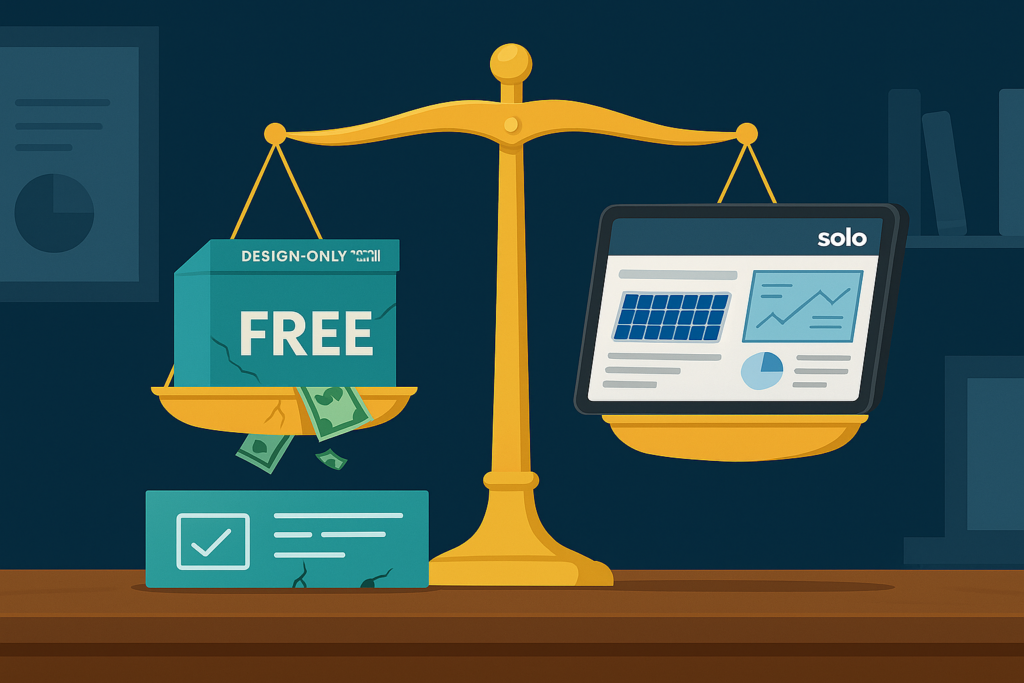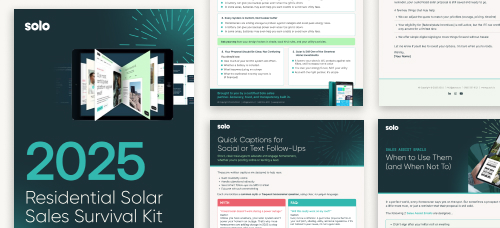The Real Cost of “Free” Solar Software

Let’s be honest: nothing in life is truly “free”—especially not your software.
On the surface, free solar design software might sound like a great way to cut overhead. But for growing teams trying to scale efficiently, these tools often become a liability instead of an asset.
Here’s what “free” really costs:
- Time: Without integration, you’re jumping between systems—one for design, another for proposals, and yet another for CRM. That means more manual entry and less time actually selling.
- Errors: Without real-time data validation, proposals are often built on outdated specs. That create misalignment between sales and ops—and costly downstream fixes.
- Missed Opportunities: Basic design tools don’t include financing workflows or pipeline visibility. That forces the teams to patch together multiple platforms, slowing growth instead of supporting it.
Disconnected tools create silos. And when your systems don’t talk to each other, your team pays the price—in stress rework, and lost deals.
Why Design-Only Tools Don’t Scale
Design software is just one part of the equation. If it doesn’t integrate with your proposals, project tracking, or customer communication, it can actually make your process more complicated.
What breaks down:
- Gaps between design, sales, and installation teams
- Version control issues when updates don’t sync across platforms
- No central source of truth: every team works from their own file or dashboard
Even the best teams end up babysitting the pipeline instead of building it. And that’s not sustainable for modern solar businesses.
Why Design Without Support Costs More Than You Think
Solo isn’t “just” design software—and that’s the point. When design tools are isolated from the rest of your sales ecosystem, you end up paying in ways that aren’t immediately obvious: rework, project delays, frustrated installers, and a breakdown in homeowner trust.
A 2023 Aurora Solar study found that 46% of solar professionals reported losing deals or facing install delays due to errors in the original design or scope. That’s nearly half of projects hitting preventable roadblocks—usually caused by disconnected workflows.
With Solo, Designs are Woven into Your Full Process:
- Homeowner-facing proposals are backed by design-ready data
- Ops teams work from the same specs promised at the point of sale
- Reps can iterate confidently without throwing off the installation
What Integration Looks Like in Practice:
With Solo, your entire sales-to-instalation process runs on one connected plaform:
- PitchDeck™ Proposals: Visual, customizable, and built with financing clarity
- Integrated Site Design: Real-time specs shared instantly across teams
- Financing Tools: Embedded loan and TPO options in the proposal experience
- Pipeline Tracking: CRM-integrated dashboards and milestone visibility
Instead of managing a stack of disconnected tools, every part of your process flows-seamlessly.
Field-Tested, Team-Approved
For solar professionals in the field, the impact of having one connected system is immediate.
“There’s a communication gap, there’s an information gap, there’s the design gap, and Solo helps us bridge that whole entire thing. I love it. I can tell [Solo is] really committed to our success.” — Mike Vergona, Urban Solar.
Design-only tools can’t support the complexity of today’s solar teams. They create more risk, more work, and more room for error.
If you’re serious about scaling your sales process, supporting your reps, and keeping installs smooth—you need more than just a design app. You need a connected system that gets it right from the first quote to the final install.
Solo brings it all together—without the hidden costs.


